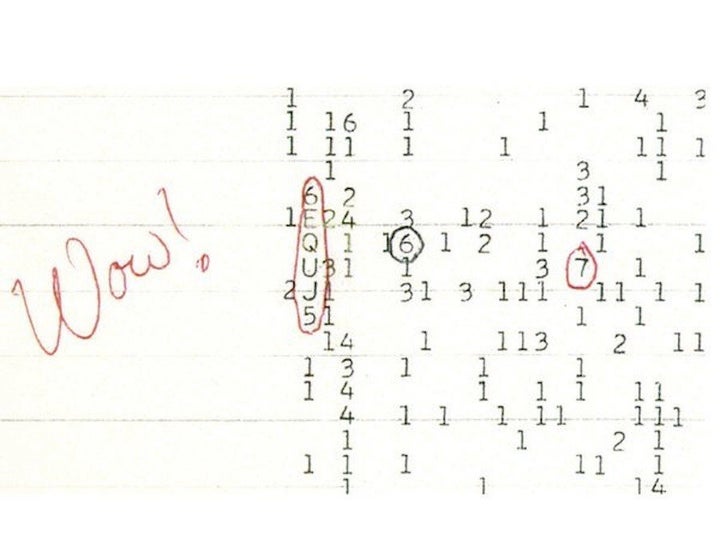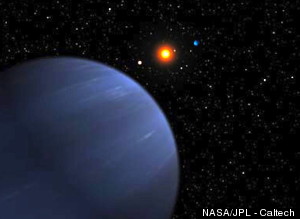
The countdown is on. On August 15, with the push of a few buttons, a Twitter experiment of galactic proportions will launch from Earth into the cosmos.
Thirty-five years ago this week, an unexplained signal was detected by scientists engaged in the Search for Extra-Terrestrial Intelligence, or SETI. Using Ohio State University's Big Ear radio observatory, astronomer Jerry Ehman noticed an unusual spike of six letters and numbers on the computer printout.
This strong, 72-second radio signal, emanating from the general direction of the Sagittarius constellation, was so odd that Ehman wrote the word "Wow!" in the left margin of the sheet, as pictured above.
The signal never reappeared, so scientists couldn't confirm if it was, in fact, a message from an extraterrestrial source. And a "response" to it was never attempted.
Until now... sort of.
In June, the National Geographic Channel's "Chasing UFOs" series premiered, which solicited viewers to go to Twitter and create their own personal messages that will be transmitted into space. It'll happen at noon, Eastern time, on Wednesday, the 35th anniversary of the original Wow! signal.
It was initially reported that our signal would be transmitted from Earth back to the area where the 1977 signal supposedly came from.
To be fair and accurate, this is not an official attempt to reply to that 1977 signal. As NatGeo explains on their site, scientists couldn't completely verify that the signal was from an alien source -- enough to warrant a response from Earth. Thirty-five years after the fact, NatGeo's "Chasing UFOs" team came up with the idea to send their own Wow! signal into space.
We have the ability to create a signal of processed tweets and aim them at specific regions in space known to have other planetary systems. NatGeo has arranged to target some of these places, hoping any ETs in the final frontier may have the proper technology to intercept and understand our tweet signal.

"We were sent a file with the tweets, and one of our engineers came up with a coding scheme that will have enough information that can be figured out -- I mean, we won't teach [extraterrestrials] English, or anything, but it should be reasonably detectable over large distances, and reasonably immune to the sorts of problems that signals that have traveled a long way have," said Michael Nolan, an astronomer at the Arecibo observatory in Puerto Rico -- the world's largest ground-based radio telescope, pictured at right.
Here are some of the hundreds of tweets gathered by the National Geographic Channel:
AronUgh:
I just wanna say that, when u have a cure against cancer, help us out. Please!
Andoni_Z:
Hello, just wanted to thank you for being there, please, reply.
mikedlv80:
Please send us a reply...It would be really nice to know we are not alone.
bmack1111:
Dear Aliens. By the time you read this, I will be long dead. Please be kind to my descendants. They will be expecting you.
KrishSangeeth:
If you really exist and plan on attacking our planet, do remember that Will Smith is still alive.
While the original 1977 signal was speculated to come from Sagittarius in the Southern Hemisphere, this new "response" signal won't actually be aimed in the same direction.
"Arecibo can't look at that spot in the sky," Nolan told The Huffington Post. "We can only look at things that are in the Northern Hemisphere, and so, we're not able to do that. There are only a couple of telescopes with powerful transmitters, and Arecibo is one of them."
To overcome that obstacle and determine exactly where to aim Wednesday's tweet transmission, Nolan consulted the work of SETI astronomers in Mountain View, Calif., who came up with possible good targets in the ongoing search for ETs.

The candidate star systems are in the constellations Orion, Gemini and Cancer. At left is an artist's conception of several planets known to orbit a star in Cancer.
Thanks to the work of powerful Earth-based telescopes and NASA's groundbreaking Kepler spacecraft, scientists now know where there are possible Earth-like planets in orbit around their own suns.
"Kepler found planets around one of these stars [in Cancer], and that's definitely one of the reasons we chose it," explained Nolan. "I used a list created by SETI scientists Jill Tarter and Margaret Turnbull, in which they chose stars [with planets] that might be habitable.
"I used that list of stars where there might be somebody there, and I found ones where the stars looked reasonably similar to our sun -- about the same color, size and age -- to say there may well be people there, too. So, that's a good place for us to look."
Even in the best case scenario of sending a signal to another star system, most astronomers have a realistic outlook about the odds of actually starting a dialogue with any alien neighbors.
In terms of travel time, one of the stars that the Arecibo transmission will target is 57 light-years away from Earth, meaning that some people alive now will still be alive when the signal gets there, but probably not if and when we hear back.
Nolan suggests we don't hold our collective breath about any ETs phoning us.
"To some extent, the odds that anybody will see this signal are really minuscule," he said. "They would have to be looking in our direction, they would have to be ready for it, they would have to guess right about a bunch of things.
"We don't really expect it to be detected. There might well be life out there and, in the greater scheme of things, maybe we will end up talking to them."
Watch this video of Comedy Central star Stephen Colbert's tweet message to outer space.
The season finale of NatGeo's "Chasing UFOs: Alien Baby Farm" airs Friday, August 17 at 10 p.m.ET/PT.
UPDATE: The original version of this story indicated that hundreds of tweets were gathered by National Geographic Channel for transmission to deep space on Aug. 15. It turns out, according to a NatGeo communications spokesperson, there were many more tweets than HuffPost was first told. NatGeo now says a file they had which contained the tweet list was corrupt and only indicated approximately 200 tweets. They have informed HuffPost the actual number, included in the space-bound transmission from the Arecibo observatory, was closer to 20,000 tweets from around the world. NatGeo has apologized for any embarrassment this may have caused.
